Posted by Elena del Valle on May 18, 2017

The Whole Foods Diet
Photos: Whole Foods Market, Grand Central Life & Style
John Mackey, co-founder and chief executive officer, Whole Foods Market joined forces with Alona Pulde, M.D. and Matthew Lederman, M.D., the latter two known for their Forks Over Knives film and books, to publish The Whole Foods Diet The Lifesaving Plan for Health and Longevity (Grand Central Life & Style, $28). The 336-page hardcover book, published this year, features the Whole Foods Market logo on the cover next to Mackey’s name.

Alona Pulde, MD and Matthew Lederman, MD, co-authors, The Whole Foods Diet
The book is divided into three parts and 15 chapters. Following an introduction by Mackey the authors speak mostly (a final chapter also is in Mackey’s voice) with a single voice, starting with an introductory section on diet and health. A second section outlines their ideas about food and their food group preferences. The remaining two chapters are dedicated to a 28-day meal plan. According to a representative from their publisher, the authors were too busy to respond to questions by email.
Although all three are vegan, they believe a diet consisting of 90 percent vegetables is healthy. Their approach to health begins with eight main food groups: Whole grains and starchy vegetables, beans and legumes, berries, other fruit, cruciferous vegetables, leafy greens, nonstarchy vegetables, and nuts and seeds. The authors dedicate an entire chapter to the groups and their beliefs about each. They dedicate another entire chapter to the ethics of being vegan.

John Mackey, co-author, The Whole Foods Diet
Mackey is co-author of Conscious Capitalism. Pulde is a board-certified practitioner of acupuncture and Oriental and family medicine. Lederman is a board-certified internal medicine physician. Pulde and Lederman were featured in Forks Over Knives and co-authored the New York Times bestseller The Forks Over Knives Plan.

Click to buy The Whole Foods Diet
Comments:
Filed Under: Books
Posted by Elena del Valle on May 11, 2017

American Surveillance
Photo: The University of Wisconsin Press
In American Surveillance Intelligence, Privacy, and the Fourth Amendment (University of Wisconsin Press, $44.95) Anthony Gregory explores the competitive interests of the United States government’s desire for unfettered access to information about its citizens and their right to privacy from undue intrusion. He begins by examining the country’s history in that regard all the way to our Founding Fathers. In this era of increasingly effective technological tools and broadening laws that facilitate a growing number of personal data breaches he concludes that the book asks more questions than it answers.
When asked what inspired him to write the book the author replied by email, “For over a decade I researched civil liberties issues for the Independent Institute, and so this book fit into that larger project. I’d been intrigued by surveillance issues since the war on terror began. Even before that I considered foreign relations and such domestic policies as the drug war to have an affinity in consequences invited more exploration.”
The hardcover 263-page book was published in 2016 in collaboration with the Independent Institute. It is written in an academic style divided into an Introduction, a Conclusion, an Epilogue and nine chapters: Reconnoitering the Frontier, 1775-1899; Foreign Influences, 1900-1945; Espionage and Subversion, 1946-1978; Calm Before the Storm, 1979-2000; The Total Information Idea, 2001-2015; Unreasonable Searches; Fourth Amendment Mirage; Enforcement Problems; and The Privacy Question. It also includes copious end notes and references.
“The main goal was to look at the intersecting issues of security intelligence and privacy rights with fresh eyes,” he said. “These are big questions with correspondingly huge literatures, and I wanted to deliver a contribution that made sense of it all, both providing a balanced analytical approach to multiple complex topics and revealing the more radical implications of what many self-described moderates on both sides of policy controversies advocate.
“I hoped it would reach both scholarly specialists and generalists as well as lay audiences concerned about policy,” he said when asked who was the target audience for the book. “It serves to curate a lot of different literatures and so can be a starting point for many different types of readers. Those in policy seeking simple answers might not find them here, but they will find some material that I hope will enhance their understanding.” In response to questions about the greatest challenge the book posed, he said: “I suppose the biggest challenge was maintaining analytical balance, and satisfying peer reviewers with different perspectives while maintaining an editorially sufficient thesis. I was surprised by many little factual discoveries on the way. I was most pleasantly surprised that some of the scholars on privacy and intelligence I had most admired found the work worthwhile!”
When asked if he found that the violation of privacy rights of Americans was justified by the safety concerns, he replied: “I try to keep some distance between my academic writing and my ideological commitments, but it’s not always possible. I think privacy advocates understate how strong the consequentialist case can be against their cause. But my view on the rightness or wrongness government surveillance is not primarily rooted in consequentialism. That’s why I think it’s more of a cultural question—not even a matter of legal rights—when we talk about privacy and surveillance. And once you know where you stand on that, you have to see what kinds of other government powers correspond to the degree of privacy you want. That often kicks the question to foreign policy or law enforcement, where sometimes measures taken do not even achieve the stated goals on their own terms. So this is a rather big question.”
Gregory is the author of The Power of Habeas Corpus in America: From the King’s Prerogative to the War on Terror, winner of the PROSE Book Award for legal studies. He is a fellow of the Independent Institute in Oakland, California.

Click to buy American Surveillance
Comments:
Filed Under: Books
Posted by Elena del Valle on May 1, 2017

Filmmaker Dana Ziyasheva
Photo: Dana Ziyasheva
A podcast interview with filmmaker Dana Ziyasheva, is available in the Podcast Section of Hispanic Marketing & Public Relations, HispanicMPR.com. During the podcast, she discusses the film Defenders of Life (see With video – New film addresses underage marriage among indigenous people) with Elena del Valle, host of the HispanicMPR.com podcast.
Dana, born in Almaty, Kazakhstan, in 1972, dreamed of becoming a writer and filmmaker. But in the Soviet Union of her childhood, opportunities for a middle-class Kazakh girl from the empire’s outskirts to make a career in cinema were virtually nonexistent. Instead Dana graduated from Kazakh State University and became a television journalist in the field covering police patrols as well as natural and political disasters.
In 1994, she used her fellowship at the Central European University in Prague, Czech Republic, to foray into Western Europe. No one, not even the Kazakh government, could believe it when the United Nations Educational, Scientific and Cultural Organization in Paris offered her a position as the youngest and first-ever international civil servant from Kazakhstan. Despite initial disapproval from her own government, Dana spent the next 20 years working for the UN in Paris, Iraq, China and Costa Rica. Between missions, negotiating with governments and implementation of international conventions and UN Plans of Action, she was involved in audiovisual projects with Central China TV and China Film Group.
To listen to the interview, click on the play button below, scroll down until you see “Podcast” on the right hand side, then select “HMPR Dana Ziyasheva” and click on the play button below or download the MP3 file to your iPod or MP3 player to listen on the go, in your car or at home from the RSS feed. Some software will not allow flash, which may be necessary for the play button and podcast player. If that is your case, you will need to download the file to play it. To download it, click on the arrow of the recording you wish to copy and save it to disk. The podcast will remain listed in the April 2017 section of the podcast archive.
Posted by Elena del Valle on April 27, 2017
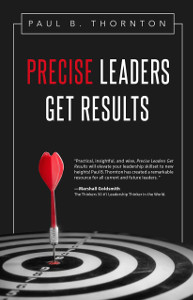
Precise Leaders Get Results
Photos: Paul B. Thornton
In Precise Leaders Get Results! (Motivational Press, $19.95) Paul B. Thornton, professor of business administration at Springfield Technical Community College, discusses his leadership ideas. His new book was written for “parents, teachers, coaches, team leaders, project managers, managers, and leaders at all levels in every type of organization.”
He begins by distinguishing between managers and leaders. Managers, he says, see themselves as preservers of the status quo. They work to achieve organizational goals whereas leaders, who by definition seek growth and improvement, promote changes to improve the status quo at all levels. There are many kinds of change and varying approaches to leadership, but what all leaders share is the desire to make a difference. Why do these issues matter? Because in the past managing employees was enough, he says, but today’s companies require managers to also be leaders.
When asked how the book came about Thornton replied by email via his publicist, “One of the courses I teach at Springfield Technical Community College is principles of leadership. For the past three years, I have used a workbook that contained many of the concepts in my published book, Precise Leaders Get Results. After each semester, I would add new material, reorganize parts, and teak the content in my workbook. I like to think that after each set of changes, the material became more focused and better organized. Overtime this workbook became my manuscript. So the short answer is it took me about three years to go from idea to publication.”
The 190-page softcover book was published in 2016 and is divided into 22 brief and easy to read chapters. Each chapter concludes with a short summary and discussion points.
“’Get results’ means that as a leader you successfully influence people to make positive changes,” the author said when asked about the book title. “Results—the right changes actually happen. The changes improve the situation.”
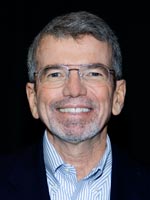
Paul B. Thornton, author, Precise Leaders Get Results
In response to a question about why he decided to write a book about leadership he replied, “Countless change efforts are underway at this very moment all over the world. Despite good intentions, many of these efforts will fail. Various reports and studies have found that 60 to 70 percent of the change initiatives don’t produce the desired results? Why? I find some leaders never get precise in answering three basic questions: Who needs to change (target and secondary groups)? What specific changes are required? Are people able and motived to make the required changes? What resources are needed?
Who will lead the implementation? I’m inspired to help leaders get precise in answering these questions so they will achieve the results they desire.”
Thornton, who has authored 15 books on management and leadership, is also a trainer and speaker. He has conducted management and leadership programs for Palmer Foundry, UMass Medical School, Mercy Health Systems, Kuwait Oil Corp., Human Services Forum, Sunshine Village and United Technologies Corp. According to his biography, through his coaching, seminars and courses, he has helped more than 10,000 people become more effective managers and leaders.

Click to buy Precise Leaders Get Results
Comments:
Filed Under: Books
Posted by Elena del Valle on April 20, 2017
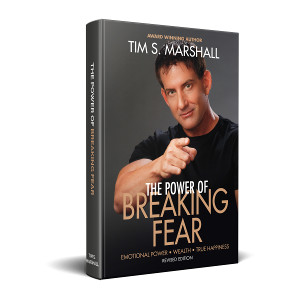 The Power of Breaking Fear
The Power of Breaking Fear
Photos: StarGroup International
Hoping to share his ideas with young professionals, entrepreneurs, and “anyone who is willing to take action to better their life” Tim S. Marshall, a public speaker and entrepreneur, authored The Power of Breaking Fear, his first book (StarGroup International, $29.95). The 212-page softcover revised edition of the book was published this year.
“I wanted to share my belief that anything is possible if you start with awareness and approach fear as a motivation, not an obstacle,” Marshall said by email via his publishing company when asked why he wrote his first book.
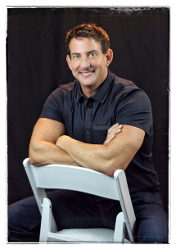
Tim S. Marshall, author The Power of Breaking Fear
The book is written in first person, easy-to-read personal style with thoughts extracted and printed on the page margins in italics. The author emphasizes his experiences and draws conclusions and recommendations from them. For example, he believes that awareness and having an open mind are essential to overcoming fear, and lead to internal and external wealth. He also says that most people are intimidated from pursuing our goals for fear that we are not good enough to succeed.
“There are varying degrees of fear based on individual circumstances and past trauma, so the obstacles may be more significant for some,” he said, when asked if everyone can overcome fear and to what degree. “However, I believe that virtually everyone has the potential to act and overcome. It’s not about disengaging the fear that prevents you from doing things that would harm you. It’s about embracing the fear that holds you back from positive things that you desire and deserve. It’s about becoming aware of those fears that stand between you and your potential and then pushing through the self-doubt and discomfort with intention.
When asked how long it took to publish the book he replied, “I took notes for 25 years. After my divorce, I wrote incessantly for a year and isolated myself in order to express these 25 years of notes, thoughts, and ideas that I gained from interacting and coaching thousands of customers and individuals.”
The author plans 20 Marshall Principles titles in total, including three before this summer. They are Entrepreneurship – Cracking the Code, Young Professionals – Frustration to Freedom, and Sales – Selling Yourself to Sell Anything. Marshall is the founder and former owner of Copysource. He has taught Fortune 500 executives at Citrix, Konica Minolta, and Toshiba.

Click to buy The Power of Breaking Fear
Comments:
Filed Under: Books
Posted by Elena del Valle on April 10, 2017

Dee Tutt, CEO, DTRS Enterprises, Inc.
Photo: DTRS Enterprises, Inc
A podcast interview with Dee Tutt, CEO, DTRS Enterprises, Inc. is available in the Podcast Section of Hispanic Marketing & Public Relations, HispanicMPR.com. During the podcast, she discusses building a beverage company from the ground up with Elena del Valle, host of the HispanicMPR.com podcast.
As a former hairstylist with no prior experience in the beverage industry, Dee spent 30 years perfecting and introducing her brand, Savîle Premium Rumtini, to the market. As her drink increased in popularity across the country, she never gave up her professional dream.
Dee’s creative side took a unique turn when she discovered a talent for mixing cocktails. Inspired by drinks she enjoyed while traveling to her favorite islands in the Caribbean and the Bahamas, she created a unique Caribbean style punch for a gathering of close friends and family. Little did she know how popular her kitchen creation, perfected over 30 years, would one day become. Named Savîle Premium Rumtini, the exotic drink became a local phenomenon, and she was encouraged to manufacture it for mass production.
To listen to the interview, click on the play button below or scroll down until you see “Podcast” on the right hand side of the page, then select “HMPR Dee Tutt” and click on the play button or download the MP3 file to your iPod or MP3 player to listen on the go, in your car or at home from the RSS feed. Some software will not allow flash, which may be necessary to view the play button and podcast player. If that is your case, you will need to download the file to play it. To download it, click on the arrow of the recording you wish to copy and save it to disk. The podcast will remain listed in the April 2017 section of the podcast archive.
Posted by Elena del Valle on April 3, 2017
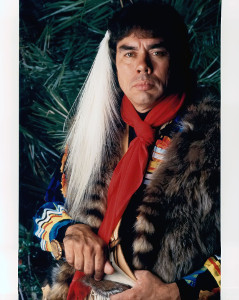
James E. Billie
Photo: Peter Gallagher
Video: Wrestling Alligators, Inc.
James E. Billie was born an outcast in the Florida swamps and grew from poverty to become chairman of the Seminole Tribe of Florida and the most influential man in his tribe. Some might say he is the most influential Native American leader in the past 100 years. Under his leadership the Seminole Tribe became wealthy from reservation gambling on its Florida land. Wrestling Alligators The New Seminole Wars, a 90-minute documentary completed in 2016, shines a bright light on Billie’s life, showcasing via vintage news clips, photos, and interviews how he became an alligator wrestler, war veteran, poet, and important leader of the Seminole Tribe of Florida. The film was shown at the Palm Beach Film last week and should be available in digital format soon. Scroll down to watch a video clip from the documentary.
Billie controlled a giant gaming organization that owns casinos and businesses all over the world including the Hard Rock Cafes and Casinos brand. Thanks in large part to his efforts, according to the documentary, the Seminole people’s lives were transformed over a 50 year span from living in small huts to being wealthy today. There are between 4,000 and 5,000 Seminoles in the tribe. As a young man Billie wrestled alligators for tourist tips. Later, he enlisted for Vietnam where he served with distinction. After the war, Billie started a chickee hut-building company and became interested in tribal politics. He was elected chairman in the late 1970s. Along the way Billie was nominated for a Grammy that launched his music career.
“We made the film to share James Billie’s and the tribe’s incredible story,” James Eowan, producer of the film, when asked by email about the purpose of the documentary. “This is a story most people have no idea about. Most people don’t know the tribe owns Hard Rock, for instance, and if they do, they have no idea how they got to that point.”
In 1972, Billie started a small high stakes bingo hall in Hollywood, Florida. It was an instant hit, leading to further gaming success, court fights with the state and federal government, and to a wealth not seen until then among Native Americans. He remains a controversial figure inside and outside his tribe, even at 72, according to promotional materials for the film. The tribe kicked him out of office as chairman of the Seminole Tribe for a decade, only to reelect him in 2011.
“We were extremely fortunate in that James Billie and the Seminoles of Florida have been covered by different facets of the media quite extensively over the years,” said Eowan when asked by email what percent of the documentary was from archival footage. “And the tribe also has quite an extensive archive of footage and stills. I would say a good 50 percent of the film is archival and the rest is footage we shot. But we ended up with close to 200 hours of shot footage once we were done.”
The film staff started working on the documentary in December of 2012 and finished it in April of 2016 with a budget of less than one million dollars from independent sources. The producers hope to capture the attention of viewers with a passing interest in Native Americans and that “the film’s quintessentially American story of a man and his people pulling themselves up from their bootstraps will appeal across all audiences.”
Posted by Elena del Valle on March 27, 2017
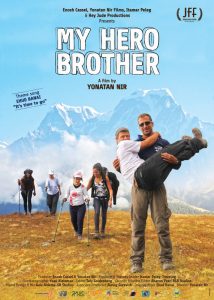
Poster for My Hero Brother
Photo, video: My Hero Brother
My Hero Brother, a heart-warming, 78-minute Israeli film in Hebrew with English subtitles completed June 2016, will be part of the 22 Annual Palm Beach Film Festival (visit pbifilmfest.org/event-calendar) taking place beginning March 29, 2017 in Palm Beach County, Florida. Scroll down to watch a trailer.
Happy and sad at the same time, the film is uplifting and inspiring. Filmed in India with a budget of $306,000 the movie shares the story of a group of remarkable young people with Down syndrome and their siblings who trek through the Indian Himalayas together. Along their journey unresolved conflicts and the complexities of growing up with a Down syndrome child in the family surface.
The idea germinated when Enosh Cassel, later a producer in the film, felt that his busy lifestyle was taking a toll because he wasn’t spending enough time with Hannan, his beloved Down syndrome brother. According to a spokesperson, “In 2011, the two embarked on a challenging trek in the Himalayas, in order to spend some much needed quality time together.” On their return, Cassel received requests from people who wanted to set out on a similar trek with their own Down syndrome sibling. On August 2013, after two years of planning and preparation, a group of 11 sibling couples (“neuro-typical” and Down syndrome) set on a journey to the Indian Himalayas, where My Hero Brother was filmed.
“In the course of the film, I hope that the viewer will undergo an experience that will change his way of looking at the main characters: not as ill-fated people who have been given a chance to experience a brief release from suffering, but rather as human beings blessed with qualities many of us yearn to have, struggling with their limitations in an highly admirable and courageous way, with the ability to open the hearts of those around them and turn them into better human beings,” the director states on the film website.
Yonatan Nir (Dolphin Boy) directed and produced by the film, which according to promotional information became an overnight success. In the first three months of distribution the producers booked 150 educational screenings in Israel, the film was accepted to several international film festivals, and won the Best Documentary Film Award and the Audience Choice Award at the Santa Barbara International Film Festival.
The filmmakers received funding from The Shalem Fund, Gesher Multicultural Film Fund, Mifal Hapais, Avi Chai Fund, and The Second Authority. In addition to the Film festival screening future information on where to view the movie may appear at myherobrother.org










 The Power of Breaking Fear
The Power of Breaking Fear














